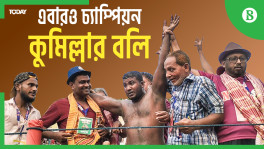Taltali Buddhist Temples: Unguarded century-old relics
The village was formed more than two centuries ago on about five acres of land. But most of the area is now empty, so various types of plants to grow freely there now

Only seven people from three families now live in Gorathakurpara village – a widely known Rakhain community about 1.5 kilometre north of the Taltali upazila head office under Barguna district.
The village was formed more than two centuries ago on about five acres of land. But most of the area is now empty, so various types of plants to grow freely there now. The landscape is a blanket of green.
Fifty years ago, Ayub Ali Laskar migrated to Taltali from his ancestral village in Patuakhali. "I got a job there as a day labourer for a Rakhain business family. They were rich people," he reminisced.

The local senior citizens, both Rakhains and the Bangalis, say that Gorathakurpara used to be home to around five hundred Rakhain families. But in 1965, a cyclone blew away most of the homes and displaced the community.
However, the cyclone spared four pagodas in the Sasana Rakhita Buddhist Temple compound. These pagodas were built in 1790, two years after the Rakhain influx from neighbouring Myanmar to parts of Cox's Bazaar, Patuakhali and Barguna in costal Bangladesh.
Maung Soe, 62, the caretaker of the temple, tells The Business Standard, "This arrangement of four pagodas in one compound is unique in Bangladesh." The temple was erected on a plinth. The six surrounding banyan trees, all wrapped up in prop roots, have been companions of the temple for well over a century.

Soe has been taking care of the temple for the last 10 years. Before he took charge, Aung Ku Ja and Van Cha Ga Ra, the last priest of the temple, looked after the place.
Soe's job is voluntary. Every morning and afternoon he goes to the base of the pagodas through a narrow gate and places flowers and water as offerings in Buddha's memory.
There are three 30-foot tall pagodas, but the fourth pagoda, which is 15-foot tall, is the oldest. They are all built of lime and brick-chips. Their walls are now damp, but they have not collapsed.
Flowers and seasonal fruit such as jackfruit, mango, litchi, and wax apple grow in abundance in the temple premises.
Soe is getting old. Almost all his childhood friends who survived the 1965 cyclone have migrated to Cox's Bazar.
"I am afraid I will not be able to look after the property alone for much longer. I have built three restrooms adjacent to the pagodas for worshipers with the donations that I received. The tin-shed structures are becoming dilapidated in this humid weather," Soe says.

He complains that young local people often intrude into the property to play cards or to smoke marijuana.
The Rakhain community of Taltali Upazila wants the government to declare the Sasana Rakkhita Temple and other such historic and religious places as heritage sites so that they are protected and maintained properly.
Tan Maung Thay, 42, the finance secretary of the Zeyarama Thirimingata Buddhist Temple at Taltali Rakhain Para, reminds everyone that Taltali is a disaster-prone area.
Maung Chin Thun, 47, the general secretary of the Rakhain Social Development Organisation, says that Rakhain people settled in 12 localities in Barguna. These are Laupara, Naushipara, Tantipara, Ankujanpara, Kabirajpara, Saudagarpara,
Talukdarpara, Monukhepara, Aga Thakurpara, Gorathakurpara, Taltalipara and Chhatonpara.
Taltali Para, where 110 people of 47 families live, is the largest hub of the Rakhain community in Barguna.
"All the communities have pagodas, but not all the pagodas are a century old. Although there are temples made of tin in each locality, only a few have statues of Buddha. They used to have statues that were imported from Myanmar and Thailand, or were locally made, but these have been stolen," Tan said with regret.
A golden-coloured pagoda on the Zeyarama Thirimingata Temple's premises can be seen from the Taltali Bazar Road.
Tan talks while walking on the slippery brick lane to the tin-shed temple where a 15-feet tall Buddha's statue is placed.
We entered the two-storied temple with our shoes off. The statue of Buddha is made of eight metals. It shines in the dim light inside the temple because there is no window, only a wooden door. The room is cool and quiet.

Printed paintings of Buddha hang on four walls. There are also paper-cuttings and memorials of U Ke La Cha Mahathero, the longest serving preacher at the temple, who died ten years ago.
After his death, the temple management committee imported a bust of Ke La Cha from Myanmar. Taltali Rakhain people preserve the bust in a glass box near the golden pagoda.
The people of the Chhatonpara community, which is close to Taltalipara, also preserve their centuries-old Chhatonpara Buddhist Temple. But they are a sparsely populated community having only 38 families.
The temple was established by Tha Thon 160 years ago. Over the years, local people misspelled his name and made it Chhaton, which still identifies the locality.
This temple is made of tin and Burma teak wood. Its interior is almost same as that of the Zeyarama Thirimingata Temple.
Young volunteer preachers manage the rituals at the temple. Most of them are from Patuakhali, Cox's Bazaar and Chittagong Hill Tracts.
Mong Choee Moia,15, from Bandarban, is an eighth grader at Taltali High School. Along with 26 others like him, Moia helps Monk Pro Gya Jota, the priest at the temple, collect food from worshippers. The food is later given to poor people and to animals in Buddha's memory.
Aung Myint, 64, who lives near the temple, says that Chhatonpara, like other local communities, has a shortage of young people. Myint is unmarried, and used to give private tuition to Rakhain students when he was young.
He also says that "Most of them migrate to towns or cities for employment. The literacy level of Rakhain people is increasing. Hence, the young generation prefers a higher standard of living,"


 Keep updated, follow The Business Standard's Google news channel
Keep updated, follow The Business Standard's Google news channel














